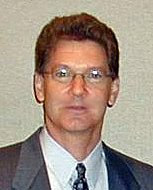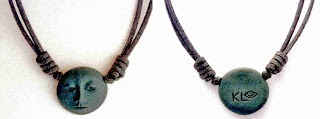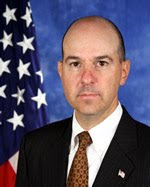The Board just said "NO" to the application of Baltimorean Gregory A. Bordes's attempt to register the mark
B-MORE for "clothing, namely shirts, sweatshirts, athletic jerseys, shorts, and hats." It granted Nike's motion for summary judgment under Section 2(e)(2), finding the mark to be primarily geographically descriptive of the goods.
Nike, Inc. v. Gregory A. Bordes, Opposition No. 91178960 (September 30, 2009) [not precedential].
 Nike Has Standing:
Nike Has Standing: Bordes asserted that Nike did not have "sufficient interest in the use of the term 'B MORE' as a geographically descriptive term for its own goods to form a basis to oppose applicant’s application." He maintained that Nike "does not use and is not in a position to use the term 'B MORE' to describe the origin of any of its goods and services inasmuch as opposer’s goods and services do not originate from Baltimore, Maryland." Bordes further argued that Nike is the junior user of the mark and therefore cannot have standing to oppose.
Nike pointed to its evidence that it has used the term "B-MORE" in connection with "products developed and marketed as part of an endorsement relationship with Carmelo Anthony, a professional basketball player who grew up in Baltimore, Maryland."

The Board ruled in favor of Nike, finding that its use of B-MORE "in connection with certain athletic apparel" established its standing. Nike did not have to prove priority because "the issue is geographic descriptiveness and not likelihood of confusion." Moreover, Nike "does not need to show it is using the mark." "It is enough to show such interest as will justify the conclusion that damage to it will ensue if the use of such term by it or its customers to describe their goods is denied." [A rather cryptic discussion by the TTAB -
ed.]
Nike Proves Geographical Descriptiveness: Nike argued that "dictionaries and reference works, as well as everyday speech and writing, define B-MORE as a geographic reference to the city of Baltimore, Maryland." Applicant admitted in discovery that "the term B-MORE is derived, in part, from the slang nickname for the city of Baltimore, Maryland, and that applicant’s business is based in Baltimore, Maryland," and he stated much the same during prosecution of his application before the USPTO.
Nike pointed to the USPTO's treatment of the term as descriptive in other cases, and it offered the declaration of a linguistics expert, who averred that "that the primary significance of the meaning of B-MORE to the general public in the United States, including consumers of apparel, is as a geographic description of the city of Baltimore, Maryland."
Applicant Bordes maintained that there remained genuine issues of material fact in dispute that precluded the entry of summary judgment. He offered his own expert and other evidence purporting to show that B-MORE "is not generally known throughout the country as being geographically equivalent to the City of Baltimore." He pointed out that his goods "are not principally manufactured in the City of Baltimore and are not identified in applicant’s marketing as being a product of Baltimore." And he contended that he "chose the B-MORE mark because of its susceptibility to multiple meanings, including the aspirational message 'Be more!'."
The Board observed that "A term is deemed to be primarily geographically descriptive, and thus unregistrable under Trademark Act Section 2(e)(2), 15 U.S.C. § 1052(e), where it is shown that (1) the primary significance of the term sought to be registered is that of a geographical place and, if so, that (2) purchasers would make a goods/place or services/place association between the goods or services at issue and the geographical place named in the mark, i.e., they would believe that the goods or services originate in that place."
It found the evidence "overwhelming" that "the general consuming public or, at a minimum, the residents of Baltimore, Maryland, and the surrounding metropolitan area, would perceive the primary significance of the term B-MORE to be a geographic designation for the city of Baltimore, Maryland."
Although Applicant's expert "suggests that the salient association of the phrase B-MORE is likely to be to the aspirational phrase 'Be more!,' the Board does not find that such evidence creates a genuine issue of material fact." "[T]he test is whether the mark is
primarily geographically descriptive, not solely a geographic designation."
The Board next found, based on Bordes's own statements, that there was no genuine dispute as to the fact that Applicant's business is located in Baltimore. Therefore, a goods/place association is presumed.
And so the Board concluded that is primarily geographically descriptive of the identified goods.
Board Discards Bogus Affirmative Defenses: Applicant's laches defense was jettisoned because laches is inapplicable in opposition proceedings. His assertion of judicial estoppel failed because Bordes presented no evidence of any other action or proceeding involving the same issue, nor any evidence that Nike ever tried to register the term B-MORE. And as to Applicant's unclean hands defense, he provided no proof whatsoever.
Finally, the Board found Bordes's purported affirmative defense that "registration of applicant’s mark is consistent with prior registrations" to be "vague;" it failed to "give rise to a valid defense under any recognizable theory." In any case. Bordes "failed to provide any clarification of said defense or any affirmative proof in support thereof."
Therefore, the Board granted Nike's motion for summary judgment.
TTABlog comment: If I see the word BOSTON on a shirt, I don't assume that it was made in Boston. Any clown from nowheresville could sell shirts with BOSTON on the front.
When I see B-MORE, I don't even think of Baltimore, let alone think the shirt was made in Baltimore. I though it meant "Be More." Perhaps the Board should have given more weight to the double entendre angle here?
Text Copyright John L. Welch 2009.



































